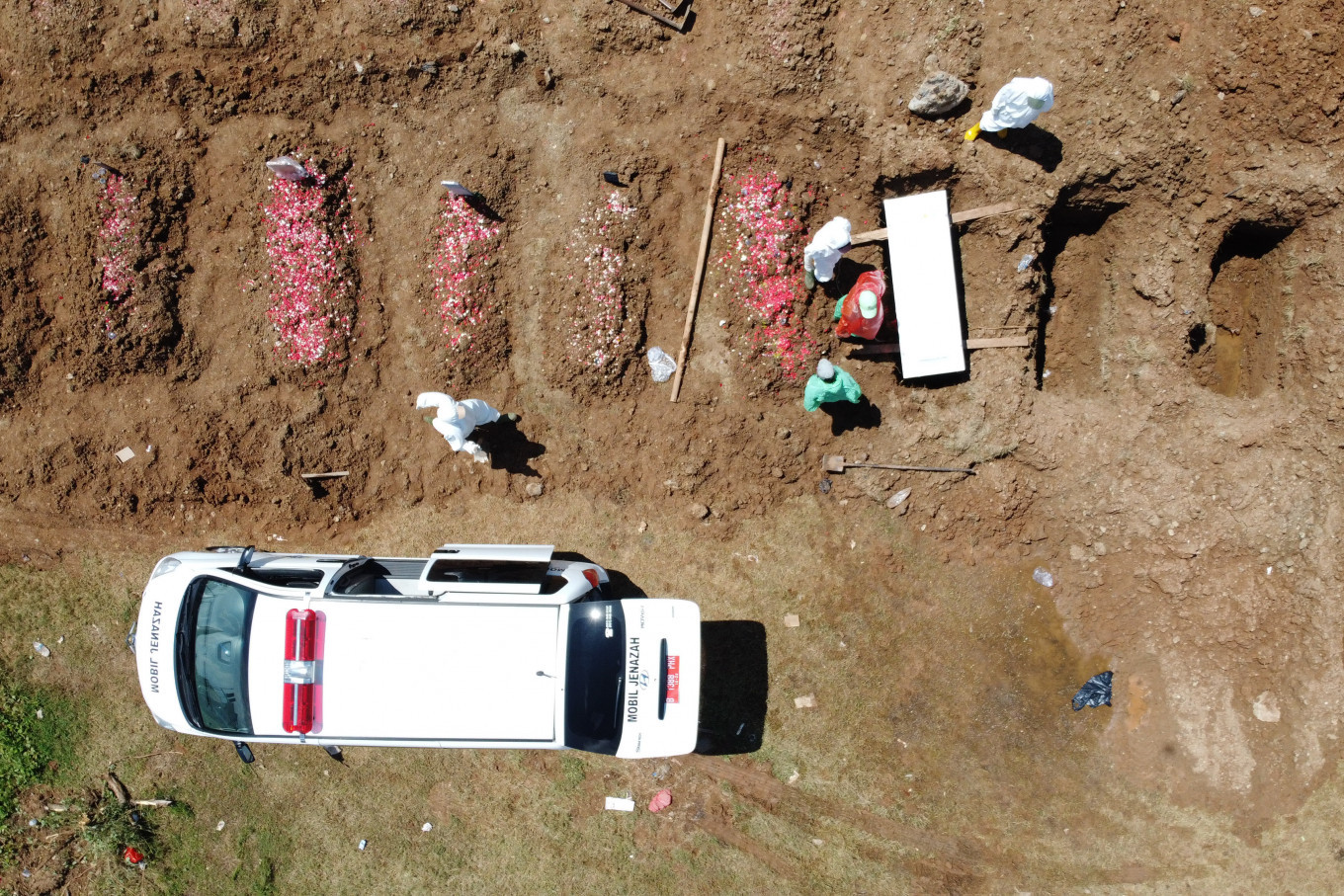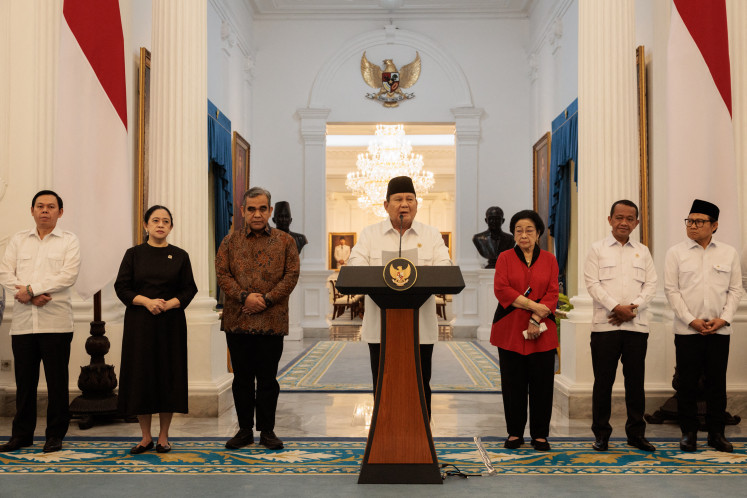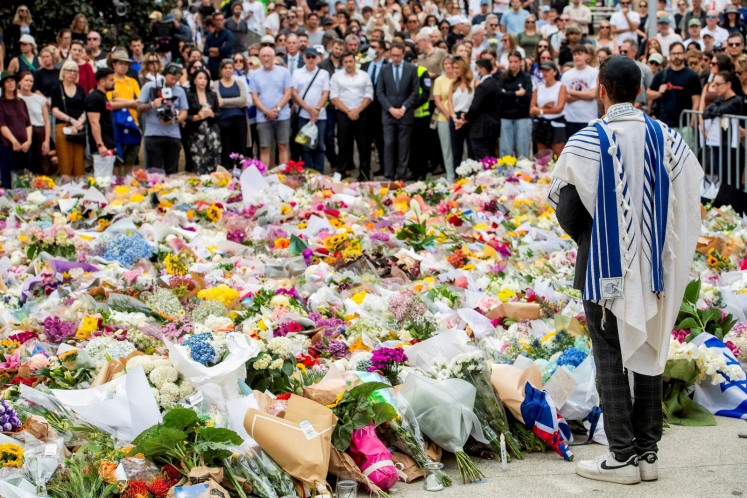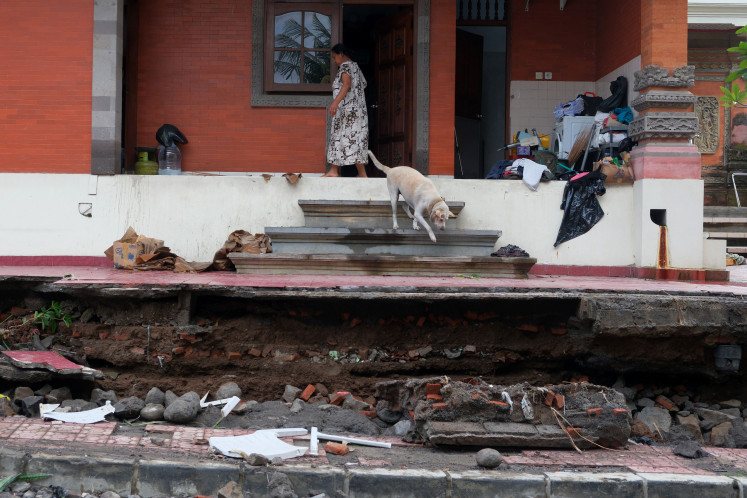Popular Reads
Top Results
Can't find what you're looking for?
View all search resultsPopular Reads
Top Results
Can't find what you're looking for?
View all search resultsCOVID-19 kills as stigma harms families and society
In the history of communicable diseases, the stigma is often more malevolent than the disease itself.
Change text size
Gift Premium Articles
to Anyone
O
n June 17, Kompas TV reported that hundreds of people had intercepted an ambulance and threatened to set it on fire and forcibly remove the remains of a person who had died after being exposed to COVID-19. It seems they thought they would suffer major problems if the body was buried under COVID-19 protocols. They would, perhaps, be under constant observation by public health personnel and the COVID-19 task force, and their village might be locked down. They might be prohibited from leaving their homes or their neighborhood. They felt they might be shunned by residents of other villages and not even allowed on the roads passing through other villages. Not only might they be ostracized, but the acknowledgement that one of their residents had died of COVID-19 could lead to restrictions on their access to normal activities, including earning a living.
Elsewhere, in a separate report, a COVID-19 victim’s family forcibly brought the remains home from the hospital and prepared the body for burial in accordance with their religious beliefs. They feared that the treatment of the body at the hospital had not followed the procedures required by their religion since the family had not been allowed to witness the process. They could not accept the fact that the body had been placed in a coffin, which they associated with the burial traditions of another religion. The family worried that they would be ostracized because the body had not been prepared according to religious tenets.
Such incidents as these, I believe, require a solution, because seizing mortal remains in this way is extremely dangerous. It was reported that 15 of the people involved in the process of bathing and wrapping the body later tested positive for COVID-19, and their village did, in fact, become a cluster under observation.
During my studies of Medical Anthropology in Amsterdam, we discussed topics such as these in our epidemiology class, viewing them as a cultural issue. “Illness” is actually more than merely the physical condition of a person who is unhealthy. It also involves traditional and cultural values and ways of thinking, which cause the illness to carry a range of other problems, such as prejudice and stigma.
One of the most ancient stigmas was that associated with leprosy. Historically, leprosy originated in Europe, the Middle East, Africa, Latin America and Asia, particularly India, and then spread throughout the world, including to Indonesia. This disease arrived with the era of colonialism in the 19th century. The bacterium responsible for the disease was first identified by a Swedish scientist in 1837. The traffic of persons between continents in the context of colonialism brought a variety of diseases with it caused by bacteria such as leprosy. The response required not just addressing the disease caused by the “leprae” bacteria but also addressing the additional disasters caused by fear and stigma. To address the spread of the disease and also to stop the “hunting” of lepers, the colonial government built special leprosy hospitals. This followed the model set by a Catholic order that built leper colonies on isolated islands. To reduce stigma and ostracism, these special leprosy hospitals were sometimes called “Lazarus Homes”, taking the name of Saint Lazarus, the patron saint of lepers.
Going beyond the issue of disease, leprosy later became a term to convey racial hatred. Leprosy was used as a metaphor to justify the ostracism or eradication of groups seen as belonging to the “other” on the basis of race, ethnicity or other distinguishing features. Even though leprosy can now be controlled with treatment and quarantine, this metaphor for hatred is still used as an excuse for eliminating others.
In the history of communicable diseases, the stigma is often more malevolent than the disease itself. People living with HIV provide a good example. The legendary singer Freddie Mercury had to keep his illness a secret until just before he died. Although the stigma of persons with HIV is not quite as severe as that of leprosy, a person still needs to think very thoroughly before publicly declaring they have HIV or even a disease considered more common, such as tuberculosis. The “informed consent ” procedure is therefore applied to protect a person’s confidentiality.
Stigma arises along with myth and prejudice. Stigma can be so strong that the patient’s family may also suffer from it. They may repeatedly deny or cover up the fact that someone in their family suffers from a disease that is stigmatized. Experience teaches us that the impact of stigma is often more severe than the disease itself. The sick person will be isolated, shunned or treated as an enemy. The family also suffers shame and humiliation because of the origin or cause of the disease. The custom of pillorying persons with mental problems is one such form of hiding shame. Similar things are often done when a family member has a physical or mental disability.
This sense of shame associated with illness is predictable given the social pressures that are experienced, even though it is not justified. Such feelings are often a form of cowardice of the healthy when they are around someone who is ill. It seems they are unable to imagine the multiple layers of consequences they would face if they did not cover it up. I remember when I was young and living in a village, there was a commotion over the death of a man who died in a firewood storage shed in the middle of a field. It seems the family was trying to hide this old man, a distant relative who was staying with them, because he suffered from acute tuberculosis. The family was afraid they would not be allowed to use the village well. In addition, they were embarrassed that a family member had TB, a “poor people’s disease”. When I was in junior high school, a student below me died from bleeding when her parents tried to perform an abortion because she was pregnant out of wedlock. She was only 13 at the time. The family concealed the pregnancy and did not take her to a doctor when she suffered severe bleeding – all out of a sense of shame.
Feelings of shame or a fear of stigmatization and its consequences, are not only experienced by patients and their families. In the case of COVID-19, fear of being isolated spreads to the wider community, giving rise to collective denial. In other cases, this is done by the authorities in the name of political and economic stability. So, in this situation, the handling of COVID-19 requires not just information about how to combat the spread of the disease but also honesty.
Explanations are needed that will change people’s attitude about COVID-19 so it does not lead to stigma and ostracism. In this regard, the handling of COVID-19 must not only be done by the Ministry of Health but also by institutions that deal directly with the public, such as the Ministry of Home Affairs and the Ministry of Religious Affairs. Here, the methods of NGOs that work to combat discrimination and hate speech can also be employed. Cultural experts must join the struggle! Distancing, yes; ostracism, no!
***
Lies Marcoes is a researcher at Rumah Kitab, Jakarta. The original Indonesian version was published on the Rumah Kitab website on June 18.










